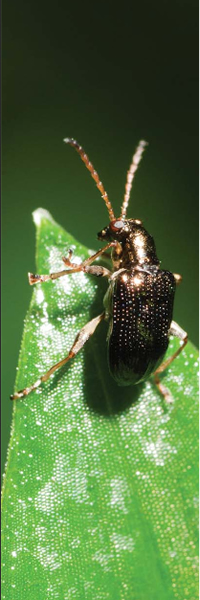Biocontrol agents battle tradescantia

The fight against one of the country’s most prolific plant pests has stepped up with the introduction of the first biocontrol agent and the planned release of two more by the end of the year.
The releases of the beetles to battle tradescantia also represent another significant highlight for Landcare Research’s world-renowned biocontrol team.
Tradescantia – or wandering Willie or wandering Jew as it is often known – has become widespread in frost-free parts of New Zealand, particularly in the North Island. Thriving in shaded areas of gardens and bush, tradescantia grows densely on the ground preventing regeneration of desirable plants. Earlier research has shown that this weed is a threat to the regeneration, and hence long-term survival, of indigenous forest in northern New Zealand.
The plant is also possibly the most widespread and troublesome weed of gardens throughout New Zealand. Tradescantia is very difficult to control as it breaks into many pieces when pulled, with even tiny stem nodes capable of resprouting. The plant can also cause canine allergic dermatitis, an itchy reaction in dogs.
In early March staff from Landcare Research and the Auckland Council undertook the first release in New Zealand of the tradescantia leaf beetle (Neolema ogloblini), in an effort to control the pest plant. It was also just the first agent released in New Zealand for tradescantia control.
 As its name suggests, the tradescantia leaf beetle feeds on the foliage of the weed. And, in July ERMA approved the release of two further biocontrol agents from Brazil, the tradescantia tip beetle (Neolema abbreviata) and the tradescantia stem beetle (Lema basicostata). Adults of both species attack tradescantia leaves while, as their names suggest, larvae burrow into either the growing tips or mature stems. Both these beetles should be released for the first time this coming spring.
As its name suggests, the tradescantia leaf beetle feeds on the foliage of the weed. And, in July ERMA approved the release of two further biocontrol agents from Brazil, the tradescantia tip beetle (Neolema abbreviata) and the tradescantia stem beetle (Lema basicostata). Adults of both species attack tradescantia leaves while, as their names suggest, larvae burrow into either the growing tips or mature stems. Both these beetles should be released for the first time this coming spring.
The releases are the result of a significant collaborative project with the Auckland Council, who applied to ERMA to release all three species of beetles.
‘Tradescantia is a nasty weed across the Auckland Region, including in our regional parks, and anything that helps control it is a fantastic step forward,’ says Cr Sandra Coney, Chair of the Auckland Council Parks and Heritage Forum.
Researcher Simon Fowler says the release of biocontrol agents in New Zealand is subject to stringent procedures imposed by the Environment Protection Agency, formerly known as the Environmental Risk Management Authority (ERMA).
‘It’s an open, obvious and honest process. All prospective agents must be thoroughly tested to prove that they are ‘host-specific’, that is, they cannot predate other plants and also that they won’t impact on human health, the environment, conservation values, primary production or Māori values.
‘The same stringent approach is taken whether the biocontrol agent is aimed at a pest plant or any other organism.’
This stringency is highlighted by the longer than expected time to introduce the tradescantia leaf beetle.
While permission was gained from ERMA to introduce the beetle in 2008 its release was delayed when standard pathogen screening revealed a gregarine gut parasite infecting the beetles held in containment.
However, towards the end of 2010 three generations of gregarine-free beetles were achieved, resulting in MAF giving permission to release the beetles from containment.
Researchers beat the disease by adopting even higher levels of hygiene for adults and newly laid eggs, reducing the likelihood of infection, and low levels of hygiene for developing larvae kept in strict solitary confinement.
‘By not keeping things too clean at this point any parasites that may be present are given the opportunity to build up to detectable levels in individual beetles, so we minimise the risk of failing to detect very low levels of infection,’ says researcher Lindsay Smith.
‘Any eggs or offspring from infected adult beetles can then be culled. All this information is recorded. We have full family trees for all of the leaf beetles and can trace each back to their great-great-grandparents. This knowledge also helps us to reduce inbreeding by making selective crosses between different lines before release.’
The ERMA process and HSNO Act that determine the suitability of biocontrol agents are both very highly regarded around the world because of their stringency, Dr Fowler says.
Biocontrol agents can be some of the most cost effective and environmentally responsible methods of controlling weeds, and Landcare Research staff are internationally renowned for their skill in this field.
While biocontrol agents don’t eliminate weeds – because they can’t find or kill every plant, their presence is more likely to result in smaller, weaker plants that are less likely to spread and can be more easily out-competed by other plants. Weed infestations may be reduced to a level that we can live with or eliminate effectively and economically by other means.
However, insect biocontrol isn’t a quick fix because it takes many years for suitable agents to be found, tested, approved, reared, released and established and then for the agents to spread.
